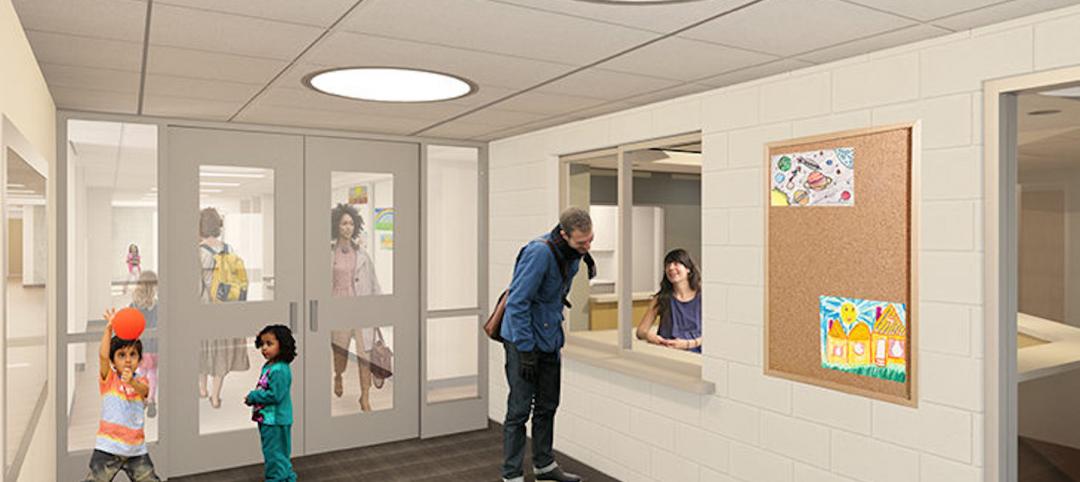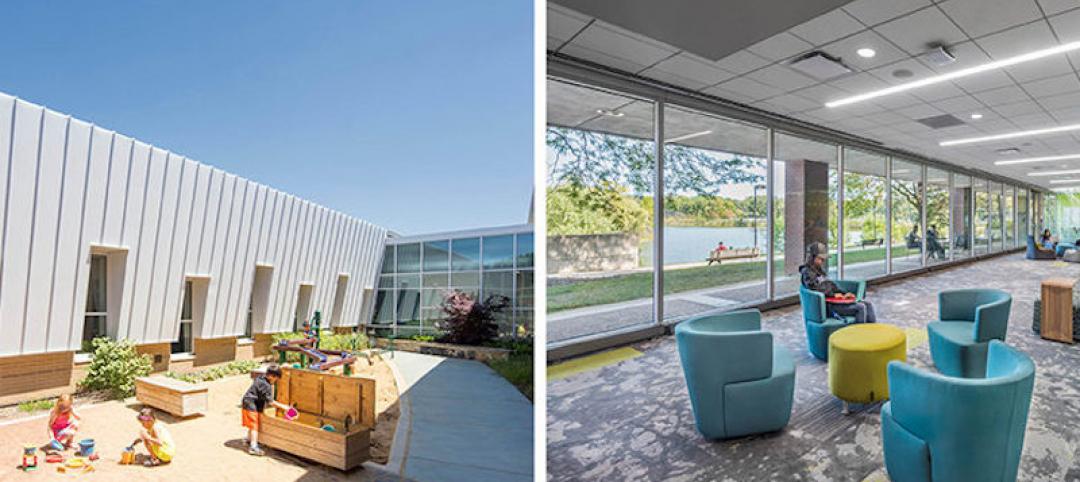I remember a children’s story about a man who got angry when neighborhood kids threw rocks at ducks. He’d yell at them, but they would keep coming back to throw more rocks. One day, as the man was about to yell again, he saw a woman approach the kids. She had colored pencils and paints. She showed the kids how to draw ducks. By the end of the story, the kids had started looking for other animals and plants to draw... and they had put down the rocks.
It’s a simple story, but it illustrates the power of teaching children to respect the environment.
 The Community Consolidated School District 59 Early Learning Center is planned around outdoor learning. It offers a large central courtyard and three smaller themed gardens (pictured), along with plenty of views outside.
The Community Consolidated School District 59 Early Learning Center is planned around outdoor learning. It offers a large central courtyard and three smaller themed gardens (pictured), along with plenty of views outside.
The Community Consolidated School District 59 Early Learning Center is planned around outdoor learning. It offers a large central courtyard and three smaller themed gardens (pictured), along with plenty of views outside.
As architects, we have the ability to shape young minds like this. However, instead of sketchpads and drawing tools, our medium is buildings. And what better place to do this than schools?
For years, schools were designed as machines for education, with double-loaded corridors that essentially ignored the environment. It’s time for a new wave of preK-12 campuses that produce their own energy, use recycled materials, and offer students natural light, views, and places to learn outside. All these factors add up to make the building a guide that, in concert with dedicated teachers, helps kids fall in love with the environment.
 Students manage gardens on the green roof at Glenbard West High School.
Students manage gardens on the green roof at Glenbard West High School.
Students manage gardens on the green roof at Glenbard West High School.
The ultimate goal of many of us in the architectural community is to design and build schools that achieve net positive energy (i.e., the building creates more energy than it consumes) and/or meet the Living Building Challenge, a rigorous sustainable building certification system.
 The design of Colin Powell Middle School, an early adopter of sustainable strategies, emphasizes natural light and views to the outdoors.
The design of Colin Powell Middle School, an early adopter of sustainable strategies, emphasizes natural light and views to the outdoors.
The design of Colin Powell Middle School, an early adopter of sustainable strategies, emphasizes natural light and views to the outdoors.
Gus Speth, the former dean of forestry and environmental studies at Yale, said the following:
I used to think that the top global environmental problems were biodiversity loss, ecosystem collapse, and climate change. I thought that with 30 years of good science we could address these problems. I was wrong. The top environmental problems are selfishness, greed, and apathy, and to deal with these we need a spiritual and cultural transformation.
In other words, the environmental challenges have been identified. Now we need to focus on who’s going to take on those challenges: our children. When they spend their formative years amid a curriculum and a setting that promote environmental awareness, they are instilled with a drive to look after that environment.
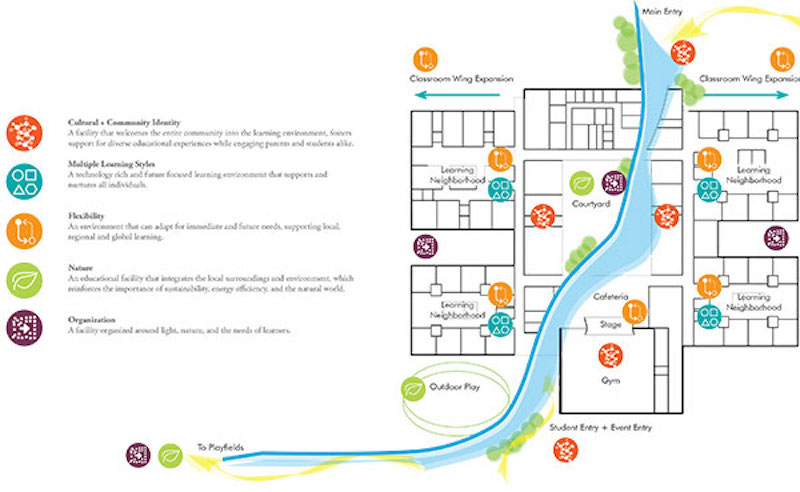 The educational vision for a new elementary school in Joliet, Illinois fuses five precepts (including nature) into the building plan. The heart of the design is an outdoor courtyard that includes elements of the region’s landscape and its relationship to a river.
The educational vision for a new elementary school in Joliet, Illinois fuses five precepts (including nature) into the building plan. The heart of the design is an outdoor courtyard that includes elements of the region’s landscape and its relationship to a river.
The educational vision for a new elementary school in Joliet, Illinois fuses five precepts (including nature) into the building plan. The heart of the design is an outdoor courtyard that includes elements of the region’s landscape and its relationship to a river.
But as with everything, there is a cost.
Schools (particularly private and charter schools) with environmental or sustainability related goals face a difficult road when it comes to raising construction funds. I think the answer lies in campaigning for a shift in mindset. Potential donors and voters need to understand the long-term benefits of supporting a district’s or a school’s efforts to train the spotlight on the environment.
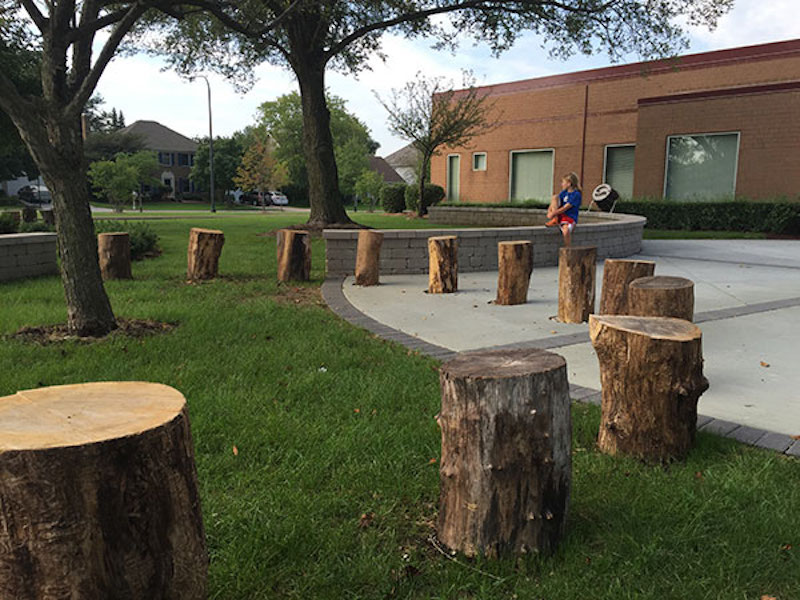 An Outdoor Education Center at Ranch View Elementary School offers a series of circular activity areas, each of which has a tree at its center. The circles offer opportunities for experiments, observation, discussions, art, music, and play. The project supports the curriculum and preserves all trees on campus.
An Outdoor Education Center at Ranch View Elementary School offers a series of circular activity areas, each of which has a tree at its center. The circles offer opportunities for experiments, observation, discussions, art, music, and play. The project supports the curriculum and preserves all trees on campus.
An Outdoor Education Center at Ranch View Elementary School offers a series of circular activity areas, each of which has a tree at its center. The circles offer opportunities for experiments, observation, discussions, art, music, and play. The project supports the curriculum and preserves all trees on campus.
If you plant an acorn, you may not see it mature into a stately oak tree, but your children and grandchildren will. So will many, many others.
Senegalese forestry engineer Baba Dioum said, “In the end, we will conserve only what we love; we will love only what we understand and we will understand only what we are taught.”
As architects and educators, let us strive to create spaces that teach environmental responsibility!
Robin Randall, AIA, LEED AP BD+C connects clients to customized design processes and teams, while encouraging environmental- and budget-conscious master planning for each project. She strives for involvement in every project and ensures the design of each learning environment supports diversity and engages students in a culture of inquisitiveness.
More from Author
Legat Architects | Feb 9, 2024
Disability and architecture: ADA and universal design at college campuses
To help people with disabilities feel part of the campus community, higher education institutions and architects must strive to create settings that not only adhere to but also exceed ADA guidelines.
Legat Architects | Jun 5, 2023
How to achieve cost-effective kindergarten classrooms
Educational architect Robin Randall shares realistic advice about the challenges of adding developmentally appropriate, play-based kindergarten classrooms while respecting budget limitations.
Legat Architects | Dec 19, 2022
Ohio University’s OHIO Esports Arena redefines video gaming
If a college student enjoys film studies, there is probably a place on campus where they can join other film buffs. But where can students who like video games go?
Legat Architects | Nov 30, 2022
10 ways to achieve therapeutic learning environments
Today’s school should be much more than a place to learn—it should be a nurturing setting that celebrates achievements and responds to the challenges of many different users.
Legat Architects | Jun 20, 2022
An architectural view of school safety and security
With threats ranging from severe weather to active shooters, school leaders, designers, and security consultants face many challenges in creating safe environments that allow children to thrive.
Legat Architects | Apr 6, 2021
Architecture and daylight: Planning strategies for energy-efficient buildings
Energy efficient, healthy, and affordable: the predictable nature of seasonal daylight geometry makes it one of the first topics to be considered when undergoing any design project.
Legat Architects | Jul 28, 2017
Achieve hospitality architecture that impresses – Multigenerational appeal, local connections
Did guests get the experience that they paid for? This question has long haunted hotel operators.
Legat Architects | Mar 30, 2017
Train station architectural design fundamentals: Accessibility
If safety is the number one priority for train stations, then accessibility comes in at a close second.






